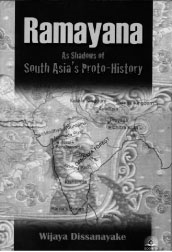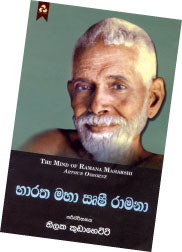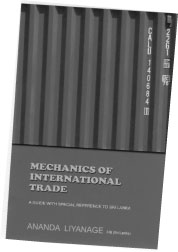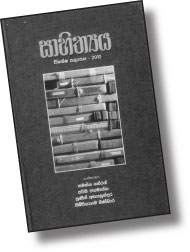|

Holding a mirror up to nature
Reviewed by Prof. Yasmine Gooneratne
A yellow Volkswagen 'beetle', a 17th century Dutch cannon, a
cigarette butt and a bottle of 'Mendis Special', two lovers on a park
bench, a young woman at a piano, and a 'mod' young man in the get-up of
a 'Bambalapitiya boy' of the 1950s: these colourful images decorate the
cover of Asgar Hussein's second published book, a volume of short
stories that is described on its back-cover as 'a satire on human
nature'. Each of these images is a part of the post-war Sri Lanka that
has become our 21st century reality, each signifies a tale, and it is
part of the pleasure afforded by Hussein's entertaining and insightful
book that each tale is well worth the telling. The Mirror of Paradise
reflects customs, manners and ways of thinking that are immediately
recognizable as our own, in a language that rings the changes on
expressions which could have been developed in no other society.
 |
|
The Mirror of Paradise
Author:
Asgar Hussein
Publisher:
Vijitha Yapa Publications |
First, a word about that term "Paradise'. The beauty of Sri Lanka's
outward aspect has been celebrated times without number, by writers from
Samuel Purchas to the present-day rhapsodists of the Tourist Board, as a
paradise of plenty and peace. Asgar Hussein's new volume, however,
reveals much about the island's inner life that is far from paradisal.
Rapidly shifting focus from board-room to beach hut, from wedding hall
to village, from a university campus to a quiet suburban street,
Hussein's 'mirror' gives back images of Sri Lanka that are at once
authentic and ironic, its thirteen stories reflecting facets of local
life which constantly seem to bemuse the narrator while being perfectly
recognizable to the reader.. "A Tale of Two Artists", a story that
explores the pretensions of the local art world, is related by just such
a bewildered innocent. "Grease Yaka", similarly framed, bestows a new
superstition on a fishing village. "The Wedding" brings together members
of two minority communities in a celebration that ends in a
free-for-all, "A Good Medical Boy" (one of the funniest tales in the
book) shows snobbery and selfishness interacting in the marriage-market,
while in "Wadakaha Sudiya" female vanity, linked to superstition and
ignorance, leads to disaster. His stories show that Hussein is well
aware of the wealth of comic potential offered by his homeland. The
situations in which his characters find themselves embroiled seem
occasionally over the top, but it does not really matter because their
creator's principal aim is to entertain, and in this he succeeds very
well. Sri Lankans love to laugh, and most of us would agree that the
life around us provides no lack of entertaining subjects. Entertainment,
however, is not satire, and although The Mirror of Paradise is a very
amusing book, in which Hussein brilliantly caricatures human
eccentricities, holding up 'as 'twere, a mirror up to nature', his
mirror is more like a distorting mirror at a fun-fair than the 'satire
on human nature' that the back-cover claims it to be. Satire requires a
great deal more than humorous entertainment, however lively that
entertainment might be; and in assessing writing of this high quality,
it's worth taking the time and trouble to distinguish one from the
other.
Adapting itself to Sri Lankan usage, satire has afforded our
journalists and playwrights a dazzling range in the past, going all the
way from, let us say, the mild satiric comedy of "Take it Easy" and
Well, Mudaliyar! to the escoriating political censure of E.M.W. Joseph's
The Financial Expert and Tarzie Vittachi's "Snowballs in the Sun". In
certain circumstances - in the face of flagrant misdemeanour, for
instance - 'it is difficult not to write satire,' as the poet Juvenal
observed, surveying the Rome of his times. In our own country today, as
in the ancient world, personalities and events attract the satirist's
eye on every side. Why, then, does Hussein, with his undoubted talent
for comedy, fail to go the extra mile?
Why, indeed! In one of the stories here ("The Gold Enterprise"),
comedy edges very close to satire ... but doesn't quite reach it. Some
wealthy business executives become the willing victims of swindlers who
claim to have invented a mechanism which will extract gold from the sea.
Unbelievable? Over the top? Not really, when one considers the
astonishing gullibility with which depositors so recently fell for the
wiles of Bernie Madoff in the USA and Golden Key in our own island
paradise. Avarice, as one of the Seven Deadly Sins (the other six being
pride, sloth, wrath, envy, lust and gluttony), is a very suitable target
for satire: comedy that exposes avarice in society with the hope of
reform certainly deserves to be called 'satire'.
But "The Gold Enterprise" does not go all the way. It is only of
their own superfluous funds that Hussein's greedy executives are
stripped. Like the hapless depositors of Golden Key, they are cheated by
crooks but, unlike them, they are not impoverished.
Is it possible that true satire does not - indeed, cannot - function
any longer in our particular province of Paradise? This view has been
advanced, and has not been denied. If satire has indeed left us for
good, it may be some consolation to learn that we are not alone in our
loss.
In modern America, according to Calvin Trillin, anyone who writes
satire finds himself confounded by the fact that events keep occurring
around him which are more fantastic than anything he could possibly
concoct. Substitute 'postwar Sri Lanka' for 'modern America', and
Trillin's remark would bring assent from every thoughtful Sri Lankan
reader.
Until satire returns to our shores, we can console ourselves with
laughter. And it is one of Hussein's strengths as a writer of comedy
that he exploits our linguistic foibles to the full. 'Har' Par' Six
Fellow'. 'How did that ha-ho happen, darling?' 'Problem is not putting
ganja'. 'A good medical boy.'
Where can we read such delightful expressions on the printed page?
Nowhere but in Sri Lanka, a land where, enriched by vocabulary and
syntax borrowed 'Take-to-take' from Sinhala, Tamil and other sources
(possibly, these days, even from Bollywood), our very own brand of
demotic English is spreading, with the blessing of academic and
educational authorities, from everyday speech into the class room ... to
make its way thence, perhaps, into the language of international
communication?
Anything is possible in a land of miracles. George Bernard Shaw wrote
(I believe it was in his comedy John Bull's Other Island), "Ceylon is
the cradle of the human race because everybody there looks an original."
Shaw's statement is particularly relevant to The Mirror of Paradise,
because Asgar Hussein has taken the 'original' characters around him as
his targets.
In choosing to focus on their absurdities (and not on any desire he
might have to denounce or reform them) he has fallen short of writing
satire, but he has created a most lively and amusing book that cannot
fail, with its vitality and comic ingenuity, to appeal to the Sri Lankan
love of laughter.
Charming fiction-essay
Reviewed by Kalakeerthi Edwin Ariyadasa
Have I discovered a new fiction-genre?
Immediately after I read this book, that was the question that crept
into my mind.
Firstly, please allow me to tell you what the book is. It is titled 'Apeksha'
(Expectations). And, again, it is the first ever book published by the
author (Ms) Jayani C. Pinnawala.
The description 'Novel' would not fit it. You would not want to call
it a novella or a novelette either. In style, it is not one of those new
fangled recite's. You could call it a work of fiction or a piece of long
fiction and say that's that. But, if you dismissed it that way your
conscience would begin to nag. Such a general definition will not
accommodate its special 'feel' - its specific 'flavour.'
Though the work is primarily a fictional narration, it possesses the
quality of an elegant essay.
Taking all those diverse factors into consideration, I decided to
call it a 'Fiction-Essay.' I am sure you will have your own thoughts.
The central character of the work is a little girl named Piyumi
Liyanaarachchi. When the story opens, she is a child of just
three-and-a-half years.
 |
|
Apeksha
Author:
Jayani C. Pinnawala
Publisher:
A Sarasavi Publication |
The reader is impressed by the stark authenticity that the writer has
been able to communicate. The seemingly realistic details, put down by
the author, hint at a semi-autobiographical spirit. The essential
elements of the story line, could vary well derive from the author's own
life-experience.
In most instances, novelists tend to create their own fictional
'Villages' on 'Settlements'. Globally reputed American novelist William
Faulkner, created the imaginary settlement Yoknapatawpha, as the
backdrop for his works of fiction.
Indian novelist R.K. Narayana, set his works in the fictional village
of Malgudi.
In the present instance author Jayani C. Pinnawela, sets her story in
Kanda Liyadda Paluwa, an actual semi-rural area, close to Colombo.
Incidentally, this specific area is known to me too as the home
territory of a former Lake House Editor Piyasena Nissanka.
What intrigues a reader, is the crowded milieu of her story. Each
segment of the narration is filled with incidents and an impressive
variety of persons. The author traces the ramifications of Piyumi's
father's family tree, dwelling intimately upon specifics.
Her work compels absorbed reading. The secret is the 'chatty'
simplicity of her diction. She does not pursue an artificially
elaborated style of writing. Her sentence structures are remarkably free
of syntactical complexities.
In effect, her prose gives the impression of a little girl's
uncomplicated reminiscences. A general atmosphere of calmness and
happiness pervades the total narration. The few incidents that mar the
joy of Piyumi's childhood are not so devastatingly tragic comparatively
speaking.
In early childhood, Piyumi has to leave her ancestral home, as the
whole family takes up residence in a smaller house.
Their ancestral home is given on rent to the officers of a company,
working a quarry in the neighbourhood.
Once while playing with her elder brother Nimal, she nearly drowns in
a barrel of water. On yet another occasion while playfully wielding a
pestle to pound paddy with elders, she accidentally 'pounds' her own
foot.
These are among the minor 'tragedies', that Piyumi faces early in her
life.
But, a tragedy that leaves a deep trauma in her growing soul, is the
separation of her parents from each other.
Eventually this, too is resolved, enabling the events to move towards
a happy ending. The narration, though devoid of 'tension' is keenly
concentrated. The essential details are focused upon with a telling
effect.
I cannot help but state that the book creates a new 'taste', for this
kind of Fiction - Essay.
Views about the book are expressed by two lady writers. In her
foreword Prof. Kusuma Karunaratne, emphasises the didactic aspect of the
work. She upholds Piyumi's courage as exemplary. To her Piyumi is "Girl
Courage". In her blurb, on the back - cover of this book, writer
Jayantha Rukmani Siriwardene observes: "This literary debut, by Jayani
C. Pinnavela enables young readers to imbibe an extremely fresh
experience."
The reader initially comes upon Piyumi as a little girl of
three-and-a-half years. The author enables the reader to trace her
progress, through various ups and downs until she is qualified to enter
the university.
To me, this total Fiction - Essay, is redolent of a fresh garden of
flowers. It exudes a compelling newness.
Even the extensively experienced readers of novels, will be
startlingly impressed by this work's surprising appeal.
In a section of the book the author recounts the story of a
pilgrimage. I am keen to draw an image from that prose area. Then
partake of kiribath and sambol.
A globe-trotter, as a matter of course, savours elaborate breakfasts.
Fruit juice, flakes, scrambled eggs on toast, marmalade, croissant,
pan-cakes with syrup - the whole range. This globe-trotter of yours,
comes home to his village. His doting mother, calls him for breakfast.
She presents a plateful of milk-rice, with a side-dish of tantalizing
sambal (reinforced with chilies and moldive fish).
The globe-trotter, is overwhelmed by this simple breakfast, presented
with mother's limitless love.
This work "Apesha" is "Kiribath and umbalakada sambol" (Milk-rice
with Maldive fish) to all seasoned readers of novels.
Glimpse into the mythical world of Rama-Ravana
Reviewed by Padma Edirisinghe
Tumbling into the fascinating world of writers from the world of
healers (Psychiatry) the author perhaps is the latest entrant to the
raging controversy on the identity of Ravana... But he gets down to the
task in the broader canvas of exploring logically the contents of the
epic poem Ramayana. His wide reading has enabled him to compare and
contrast the Greek epic poems Iliad and Odyssey with this Indian hymnal
work of Valmiki composed in Sanskrit around 350 BC. He states that all
these epic poems could lend themselves to purely mythical
interpretations as they encase much that is fantastic and supernatural
"with gods and demons actively participating in the affairs of men". Yet
in 1871 a German archaeologist had unearthed the main city of Homer's
Iliad story. Troy in NW Turkey. From here the professor gets on to his
next query, "If the Iliad of Homer possesses a solid historical basis,
is it possible to maintain that the Ramayana is purely mythical with no
foundation in history?". One almost gets on to the verge of concluding
that the controversial figure of Ravana is real, but the author now
drifts back, "Main theme of this text is that the Ramayana contains in
essence, not a natural myth but shadows and glimpses of the ancient
history of the subcontinent".
 |
|
Ramayana
Author:
Wijaya Dissanayake
Publisher:
Sooriya Publishers |
That probably casts the Ramayana story plus the figure of Ravana into
Shadowland; into more or less a mythical world where things could have
had really happened or not and the characters presented could be real or
carved out of human imagination.
It is rather thrilling to trace the author's trail of thought in this
matter that he impregnates with a professional dimension pregnant with a
high research approach.
The technique gets away to high ground from the mundane quarrels on
the issue, "Whether the Ramayana is a history text or a fake literature
and whether Ravana himself is real or not?". Tempers have hotted up and
insulting banshee cries have been even raised on the issue. Hence it is
nice to relax with a rather academically treated and balanced work on
the subject. Dissanayaka's "Ramayana" written in elegant English and
rich in beautiful phraseology can be broadly described as a study and
analysis of Valmiki 's Ramayana mainly from the approaches of its
historicity, "exploring the probability of it containing features of
South Asia's proto-history.
Chapter 1 goes on to discuss the basic factors pertaining to this
issue including as to what is meant by proto-history.
The author goes on to elaborate on the causes leading to Lankan
interest in the Ramayana, the chief of which is that the Ramayan story
has led to the belief among circles who bother about such things (not
the circles who keep seeking their bread and pol-sambol) that long
before Vijaya's advent that a mighty emperor named Ravana ruled here
whose domain extended to Central India. Perhaps with the tide of
patriotic feelings getting frenzied due to recent political events, the
Ravana story gathered in momentum. It needed little bolstering since the
epic of Ramayana had not only enthraled the Indians but had blazed right
across South Asia even including Muslim Java.
Writes the professor, "Seeing the Rama - Ravana puppet shows in Java
and listening to legends in Thailand that refer to him as a past ruler
of the island stimulated my interest in the Indian epic which led to a
quest lasting many years". It was also a quest in search of the historic
figure of Ravana.
One may get tensed while going on reading the narrative, especially
when sensing that the author has finally hit upon the specific identity
of Ravana hopefully as a mighty emperor of our island, when things begin
to flop. Poor Ravana, he ends up a tribal chief of Central India,
haunting the jungles and has no connection to Sri Lanka! Is the play
over? No. Dissanayake's discovery, fortunately is not the final scene in
the play. It is left for others interested to open up the curtains and
participate in the play of discovery and identification.
But Dissanayake has engineered a very forceful motivational set up
throbbing with relevant facts and we have to thank him for it. The book
comes out very timely when a Muslim mosque in Ayodhya is said to have
been identified as that which encases Rama's Janmabhoomi memorial
entombed after the spread of Mogul power (that fact is not in the
reviewed book but info got from newspapers by reviewer). Who knows one
fine day somebody may come upon some similar valuable archaeological
evidence regarding the Great Empire of Ravana, which nexus of power was
our own little Island! "Dream, Oh! innocent folk! Mired in the bliss or
curse of doubt But let not dreams be your master!"
Book launch
Bharatha Maha Rushi Ramana

Thilaka Kudahetti's latest book "Bharatha Maha Rushi Ramana" will be
launched at Dayawansa Jayakody Bookshop, Ven. S. Mahinda Mawatha,
Colombo 10 on November 9 at 10 a.m.
"Bharatha Maha Rushi Ramana" is the authentic Sinhala translation of
Arthur Osborne's popular work "The mind of Ramana Maharshi".
Kudahetti is the author of several other books such as "Nethata
andunak se", "Vathsunu pavatha", "Durga Tharanaya", "Neela desa nisa", "Sansara
Bandana", "Chathura", "Bharatha yogin saha isivarayin samaga", "Pyramid
bhuthayin Egyptu Sannasin ha mathrakaruvan samaga", and "Kulagei
vilanguva".
"Bharatha Maha Rushi Ramana" is a Dayawansa Jayakody publication.
Mechanics of International Trade

"Mechanics of International Trade" by Ananda Liyanage and its
Sinhalese translation Jatiyantara Velada Yantranaya will be launched on
November 12 at 4.30 p.m. at the Institute of Bankers of Sri Lanka (IBSL),
College of Banking and Finance Auditorium at 1081, Maradana Road,
Borella.
Sahithya special volume

Sahithya, special volume published by the State Literary Panel in
collaboration with the Department of Cultural Affairs will be launched
on November 11, at 3.00 p.m. at Sri Lanka Library and Documentation
Services Board's auditorium.
Prof. Jinadasa Dhanansuriya, Head of the Department of Sinhala of the
University of Kelaniya will deliver a lecture on the volume. Sahithya
special volume is made up of 46 academic articles and some of the
contributors include Prof. Wimal Dissanayake, Prof. Vinnie Vitharana,
Prof. Balagalle, Prof. W.S Karunatileke, and Prof. K.N.O Dharmadasa. |

